 |
Figure 1. Location of the H11997 study area (red polygon) and other bathymetric and backscatter surveys completed in Long Island Sound. Also shown are the locations of onshore end moraines (black polygons). Surveys by the National Oceanic and Atmospheric Administration Ships Thomas Jefferson and Rude are shown in light gray and include H11043—Poppe and others (2004, 2006a); H11044—McMullen and others (2005), Poppe and others (2008a); and H11045—Beaulieu and others (2005); H11255—Poppe and others (2006b); H11250—Poppe and others (2006c, 2007a); H11252/H11361—Poppe and others (2007b, 2008b); H11441/H11442/H11224/H11225—Poppe and others (2010); H11445—McMullen and others (2010); H11251—Poppe and others (2010); and H11446—McMullen and others (2011). Sites of USGS sidescan-sonar surveys are shown in dark gray and include Norwalk—Twichell and others (1997); Milford—Twichell and others (1998); New Haven Harbor and Central Long Island Sound (CLIS) Dumping Grounds—Poppe and others (2001); Roanoke Point—Poppe and others (1999a); Falkner Island—Poppe and others (1999b); Hammonasset—Poppe and others (1997); Niantic Bay—Poppe and others (1998c); New London—Lewis and others (1998), Zajac and others (2000, 2003); Fishers Island Sound—Poppe and others (1998b). |
 |
Figure 2. Port-side view of the National Oceanographic and Atmospheric Administration Ship Thomas Jefferson at sea. The 30-foot survey launch normally stowed on this side of the ship has been deployed. |
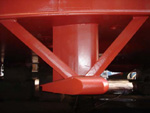 |
Figure 3. The RESON 7125 multibeam echosounder system hull-mounted to the National Oceanographic and Atmospheric Administration Ship Thomas Jefferson. |
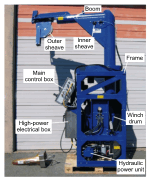 |
Figure 4. Brooke Ocean Technology Moving Vessel Profiler with a Sea-Bird Electronics, Inc. conductivity-temperature-depth (CTD) profiler used to correct sound velocities for the multibeam data. |
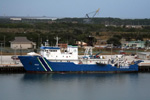 |
Figure 5. A port-side view of the Environmental Protection Agency (EPA) OSV Bold that was used to collect bottom photography and sediment samples in the study area offshore in eastern Long Island Sound. |
 |
Figure 6. The mid-sized Seabed Observation and Sampling System (SEABOSS), a modified Van Veen grab sampler equipped with still and video photographic systems. |
 |
Figure 7. Locations of stations at which bottom samples and photographs were taken during U.S. Geological Survey cruise 2010-015-FA aboard the OSV Bold to verify bathymetric data. |
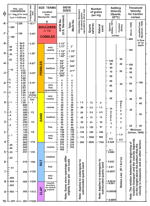 |
Figure 8. Correlation chart showing the relationships among phi sizes, millimeter diameters, size classifications (Wentworth, 1922), and American Society for Testing and Materials and Tyler sieve sizes. Chart also shows the corresponding intermediate diameters, grains per milligram, settling velocities, and threshold velocities for traction. |
 |
Figure 9. Sediment-classification scheme from Shepard (1954), as modified by Schlee (1973). |
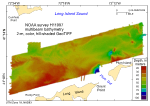 |
Figure 10. Digital terrain model of the sea floor produced from the multibeam bathymetry collected during National Oceanographic and Atmospheric Administration survey H11997 and gridded to 2 m. Image is sun-illuminated from the north and vertically exaggerated 5X. Hotter colors are shallower areas; cooler colors are deeper areas. See key for depth ranges. |
 |
Figure 11. Interpretation of the digital terrain model from National Oceanic and Atmospheric Administration survey H11997. Areas characterized by rocky seabed, sand waves, megaripples and ripples, dredge spoils, and shipwrecks are shown. White areas within the study area are primarily winnowed sea floor armored with gravel. Shipwreck is the small blue polygon in the north-central part of the study area. |
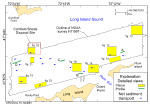 |
Figure 12. Locations of detailed planar views of the digital terrain model (yellow polygons) and profiles of sand-wave symmetry (green lines). Directions of net sediment transport (blue arrows), interpreted from obstacle marks and bedform asymmetry, and location of the Cornfield Shoals Disposal Site (red dashed line) are also shown. Profiles A-D are shown in figures 19 and 20. |
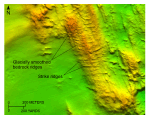 |
Figure 13. Detailed planar view of exposed bedrock from the digital terrain model produced from bathymetric data collected during National Oceanic and Atmospheric Administration survey H11997. Glacially smoothed bedrock ridges parallel similar features and glacial striations onshore (Goldsmith, 1962); strike ridges parallel those of the onshore Avalon Terrane. Location of view is shown in figure 12. |
 |
Figure 14. Detailed planar view of the rough bouldery sea floor north of Plum Island from the digital terrain model produced from bathymetric data collected during National Oceanic and Atmospheric Administration survey H11997. Boulders rest on the surface of the submerged Harbor Hill-Roanoke Point-Fishers Island end moraine. Location of view is shown in figure 12. |
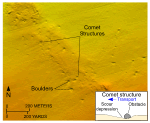 |
Figure 15. Detailed planar view of the bouldery sea floor northwest of Rocky Point from the digital terrain model produced from bathymetric data collected during National Oceanic and Atmospheric Administration survey H11997. Boulders rest on the winnowed northern flank of the submerged Harbor Hill-Roanoke Point-Fishers Island end moraine. Scour-mark asymmetry around the boulders suggests net westward to southwestward sediment transport. Location of view is shown in figure 12. |
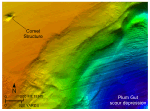 |
Figure 16. Detailed planar view of the large scour depression at the northern entrance to Plum Gut from the digital terrain model produced from bathymetric data collected during National Oceanic and Atmospheric Administration survey H11997. Note the presence of a comet structure suggesting westward transport and the small sand-wave field in the scour depression. Location of view is shown in figure 12. |
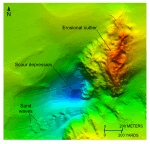 |
Figure 17. Detailed planar view of an erosional outlier north of Plum Island from the digital terrain model produced from bathymetric data collected during National Oceanic and Atmospheric Administration survey H11997. Note that sand-wave asymmetry suggests westward transport and that a scour depression occurs in the lee of the outlier. Location of view is shown in figure 12. |
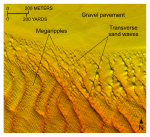 |
Figure 18. Detailed planar view of transverse sand waves from the digital terrain model produced from bathymetric data collected during National Oceanic and Atmospheric Administration survey H11997. Note that the transition from the surrounding gravel pavement is abrupt and that megaripples progressively give way to sand waves which in turn are replaced by sand waves covered with megaripples. Location of view is shown in figure 12. |
 |
Figure 19. Cross-sectional views of transverse sand waves from the eastern part of the digital terrain model produced from bathymetric data collected during National Oceanic and Atmospheric Administration survey H11997. Sand-wave asymmetry indicates a westward net sediment transport; the presence of megaripples on stoss slopes suggests transport is active. Locations of profiles are shown in figure 12. |
 |
Figure 20. Cross-sectional views of transverse sand waves from the western part of the digital terrain model produced from bathymetric data collected during National Oceanic and Atmospheric Administration survey H11997. Sand-wave asymmetry indicates a westward net sediment transport; the presence of megaripples on stoss slopes suggests transport is active. Locations of profiles are shown in figure 12. |
 |
Figure 21. Detailed planar view of relatively straight-crested, symmetrical, non-bifurcating transverse sand waves from the digital terrain model produced from bathymetric data collected during National Oceanic and Atmospheric Administration survey H11997. Note the presence of scour depressions or moats at the ends of the sand waves. Location of view is shown in figure 12. |
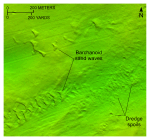 |
Figure 22. Detailed planar view of barchanoid sand waves from the northwestern part of the digital terrain model produced from bathymetric data collected during National Oceanic and Atmospheric Administration survey H11997. Orientation indicates a southwestward net sediment transport. Note the presence of dredge spoils. Location of view is shown in figure 12. |
 |
Figure 23. Detailed planar view of barchanoid sand waves from the southwestern part of the digital terrain model produced from bathymetric data collected during National Oceanic and Atmospheric Administration survey H11997. Orientation indicates a westward to southwestward net sediment transport. Location of view is shown in figure 12. |
 |
Figure 24. Distribution of sedimentary environments based on the digital terrain model from National Oceanic and Atmospheric Administration survey H11997 and verification data from U.S. Geological Survey cruise 2010-015-FA. Areas characterized by coarse bedload transport and erosion or nondeposition are shown. |
 |
Figure 25. Station locations from U.S. Geological Survey cruise 2010-015-FA used to verify the acoustic data from National Oceanic and Atmospheric Administration survey H11997, color-coded for sediment texture. See key for sediment classifications. |
 |
Figure 26. Hydroids and sponges covering boulders at stations 997-1 and 997-24, respectively. These organisms are commonly absent from cobble-sized and smaller gravel that are mobile in high-energy environments. Station locations are shown in figure 25. |
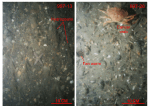 |
Figure 27. Gravel armors the sea floor in the high-energy environments at stations 997-13 and 997-26 and throughout much of the study area. Station locations are shown in figure 25. |
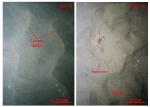 |
Figure 28. Bottom photographs from stations 997-8 and 997-10 of current-rippled sand that is prevalent in areas characterized by sedimentary environments of coarse-bedload transport. Station locations are shown in figure 25. |
 |
Figure 29. Locations of stations at which bottom photographs were taken during U.S. Geological Survey cruise 2010-015-FA aboard the OSV Bold to identify the sea-floor sedimentary environments and habitat. |